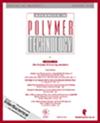Low Temperature, In Situ Polymerization of Vinyl Acetate in Silica Containing Emulsion Gels
IF 2
4区 工程技术
Q3 ENGINEERING, CHEMICAL
引用次数: 0
Abstract
Vinyl acetate (VAc) was polymerized to about 90% conversion in 9 h at 40°C from the colloidal microstructure of the VAc/fumed silica/cetyltrimethylammonium bromide (CTAB) system. The glass transition (Tg) of poly(vinyl acetate) (PVAc) polymerized in these emulsion gels with silica was higher (Tg = 41°C) than those of PVAc made from bulk polymerization at 60°C (Tg = 31°C) and the weight average molar mass (Mw) was also larger (Mw about 300 kg/mol) than those from bulk polymerization (Mw = 125 kg/mol). Increased Mw, Tg, and lowered processing temperature for these composites could facilitate new applications for PVAc.

醋酸乙烯酯在含硅乳液凝胶中的低温原位聚合
乙酸乙烯酯(VAc)在9分钟内聚合至约90%的转化率 在40°C下从VAc/气相二氧化硅/十六烷基三甲基溴化铵(CTAB)体系的胶体微观结构中分离h。在这些含有二氧化硅的乳液凝胶中聚合的聚乙酸乙烯酯(PVAc)的玻璃化转变(Tg)更高(T g=41°C)比在60°C下由本体聚合制成的PVAc(T g=31°C)和重均摩尔质量(Mw)也较大(M w约300 kg/mol)比来自本体聚合的那些(Mw=125 kg/mol)。增加Mw,Tg和降低这些复合材料的加工温度可以促进PVAc的新应用。
本文章由计算机程序翻译,如有差异,请以英文原文为准。
求助全文
约1分钟内获得全文
求助全文
来源期刊

Advances in Polymer Technology
工程技术-高分子科学
CiteScore
5.50
自引率
0.00%
发文量
70
审稿时长
9 months
期刊介绍:
Advances in Polymer Technology publishes articles reporting important developments in polymeric materials, their manufacture and processing, and polymer product design, as well as those considering the economic and environmental impacts of polymer technology. The journal primarily caters to researchers, technologists, engineers, consultants, and production personnel.
 求助内容:
求助内容: 应助结果提醒方式:
应助结果提醒方式:


